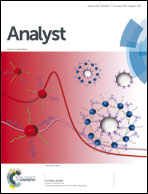Design and synthesis of ultrasensitive off–on fluoride detecting fluorescence probe via autoinductive signal amplification†
Abstract
We prepared an off–on fluorometric probe, DPF1, by incorporating the concept of autoinductive signal amplification into its molecular design. In the presence of fluoride, DPF1 undergoes a cascade of self-immolative reactions concomitant with unmasking fluorogenic coumarin, which results in the ejection of two fluoride ions. These fluoride ions are continuously activating the cascade reaction and accumulating coumarins, which leads to exponentially amplifying the signal with high sensitivity. The fluorescence signal generated by this cascade reaction is rapid, specific and insensitive to other anions. Its limit of detection was 0.5 pM, considerably lower than other current methods of fluoride detection. In addition, DCC, a long wavelength fluorometric probe, was prepared. Interestingly, an assay platform coupling DPF1 and DCC showed an outstanding sensing ability at higher wavelengths, suggesting that this can be a promising method for the sensitive and selective detection of fluoride in biological samples. The practical applicability of the proposed approach has been demonstrated in urine and water samples.


 Please wait while we load your content...
Please wait while we load your content...